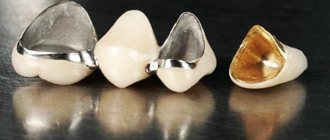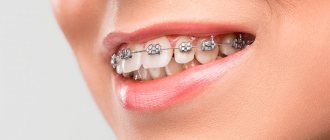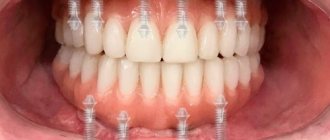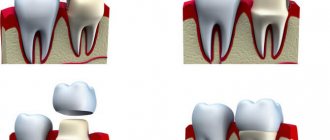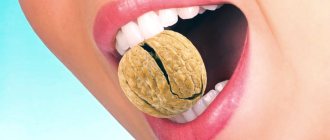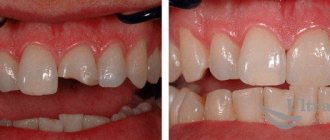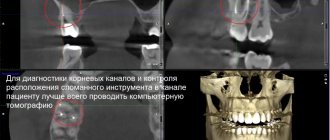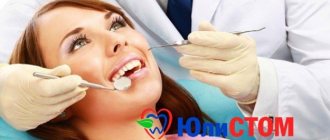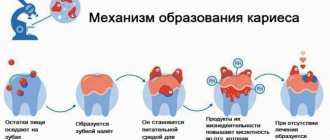Fracture of the front teeth occurs quite often in the practice of a dentist. This defect can be mild and affect only a small area of enamel, but sometimes the front tooth breaks at the root. What to do in such situations? Of course, go to the dentist. Today there are many methods that allow you to correct the problem, taking into account the individuality of each case.
The crown part of the front tooth is broken
If a front tooth is partially fractured, veneers or crowns can be used.
Veneers restore tooth function, protect dentin from external influences, and also the aesthetics of a smile. Treatment is only suitable for slightly damaged teeth. If the dental crown is severely damaged, the dentist will suggest installing a ceramic crown.
Crowns are placed on the remaining part of the tooth after grinding and preparing the surrounding area around the damaged tooth. If a significant part of the tooth has broken off, then to securely fix the crown it will be necessary to make a stump inlay, and in this case the tooth will have to be depulped (remove the nerve and fill the root canal).
The main stages of tooth restoration using a crown:
- Drawing up and agreeing on a treatment plan;
- Next, the doctor grinds the tooth down for a crown;
- Taking a silicone impression. The impression is sent to the dental laboratory. Based on the impression, the technicians reconstruct a plaster model of the teeth, and the technician will model the crown on it;
- When the crown is made, it is tried on and, if there is no discomfort, fixed on the stump.
To close the aesthetic defect, until the permanent crown is made, I install temporary plastic crowns on the patient, which can be made either in the laboratory or in the clinic.
Material for making dental crowns . Front teeth are a person’s calling card. When smiling, in conversation, every person involuntarily exposes his front teeth. Their beauty and health attract their interlocutor. This is why choosing the type of crown for teeth in the smile area is so important. The main types of permanent dental crowns are metal-ceramics, metal-free ceramics and ceramics with a zirconium dioxide frame. The most preferable material, from an aesthetic point of view, for the manufacture of dental crowns for the front teeth is metal-free ceramics e.max or feldspathic ceramics, also ceramics with a zirconium dioxide frame.
conclusions
- Restoration is possible if the upper, lower, front or side teeth have broken off;
- For restoration, methods of mineralization, plugging with a composite, extension, prosthetics with a crown on a pin, or a stump inlay are used;
- if the root is preserved, the tooth can be restored, even if the coronal part is fractured at the base;
- a root fracture can be treated if the pulp is not damaged;
- in cases where the tooth cannot be saved, it is removed, followed by implantation or installation of a bridge;
- The implant performs all the functions of a natural tooth and prevents bone tissue atrophy;
- the extended tooth is no different from others and looks natural.
Expert of the article Bolshakova Evgenia Vladimirovna Dentist-hygienist
More than 11 years of experience
Restoration method – bridge prosthesis
Dental bridges got their name for their visual resemblance to a bridge - they are a structure of two crowns, between which artificial teeth are located.
Crowns are placed on your own ground teeth. The advantages of bridges are good aesthetics and reliable fixation. Dental bridges are permanent, making them very comfortable. This type of dental prosthetics requires several visits to the doctor. First, impressions are made, from which a temporary prosthesis is made in a denture laboratory or clinic - the patient will not experience discomfort when communicating due to the absence of a front tooth. At the same time, the dental clinic prepares the supporting teeth. They are ground to install a crown to a shape that is optimally suitable for this, and most often (but not always) they are depulped. After the grinding is completed, impressions are taken again, from which dentists make a permanent prosthesis, and after that it is installed on the supporting teeth and fixed with cement.
The main disadvantage of a bridge is the need for depulpation and grinding of healthy supporting teeth. In addition, its installation, which leads to an uneven load on the alveolar bone and its thinning in the area of the missing tooth..
Peculiarities
Doctors distinguish three stages of tooth decay: minor, partial and complete. Based on the amount of remaining living tissue, the dentist chooses the method and material for restoration. In some cases, it is enough to fill a small chip with a composite or partially build it up with appropriate materials to give it a natural color and shape. If the tooth is completely destroyed, the question of making a prosthesis arises. In this case, therapeutic treatment is pointless, and a prosthetist dentist is involved in the process.
Restoration method - one-stage implantation immediately after root removal
Single-stage implantation of a front tooth involves immediately installing an implant into the socket after tooth extraction. For this type of implantation, special dental implants with aggressive threading and a high degree of primary stabilization are used. On the same day, immediately after implantation, a temporary plastic crown is installed. This implantation allows you to solve two problems - removing a broken tooth root and closing a cosmetic defect. In addition, the method allows you to save a little, because... Some manipulations are not performed (for example, the gum former is not installed).
After 3-4 months, when osseointegration of the implant is complete, permanent crowns are installed. Just as in the case of conventional crowns, from an aesthetic point of view, the best solution for the front teeth is the use of ceramic crowns and, accordingly, abutments. It is preferable to install the crown on a zirconium dioxide abutment, then in any type of lighting the crown will not stand out from the general row of teeth. In our opinion, this option for restoring a broken front tooth is the most optimal.
First aid for a fracture
If an accident occurs before your eyes, you should make sure that the victim has no other injuries or a threat to life and only then focus on the tooth. Next, you should take it to the dentist as quickly as possible, having first tried to exclude infection and relieve pain:
- if there is bleeding, rinse your mouth with water, apply a piece of cotton wool or bandage to the injury site and press firmly - pressure will help stop the bleeding;
- for severe pain, give analgesics or NSAIDs, apply a cold compress (not ice);
- If you suspect a jaw injury, secure it with a bandage.
Cold compress
Chamomile infusion effectively soothes and disinfects open pulp; it is good if this remedy is at hand at the right time. Try to find the tooth or its fragments and bring it to the dentist, this will make it easier to assess the condition of the dental tissues and decide on the method of treatment.
Important! To avoid infection, perform all manipulations with clean hands.
Chamomile decoction
The most basic and obvious sign of such injuries is pain in a broken tooth, sometimes very severe, especially when trying to open or close the jaw. Fractures are also characterized by loosening of adjacent teeth, speech impairment, and bleeding gums. When the upper enamel layer is damaged, the pain is much less than when the deep tissues (pulp, dentin, root) are affected. Sometimes (this is extremely rare) a broken tooth may not hurt at all, but even in this case, seeing a doctor is necessary.
Broken tooth pain
Causes of dental chips
There are many circumstances that can lead to partial tooth destruction; among the most common, experts note the following:
- Injuries received by mechanical means, from which people who lead an active lifestyle or choose extreme sports are least insured (children jumping like saigas and teenagers fighting behind garages also fall into this category). Although, by and large, this reason is quite common, tooth damage can be caused by blows, falls, accidents, which, unfortunately, happen every day.
- Demineralization of tooth enamel, lack of calcium, fluoride and other microelements necessary to strengthen teeth are typical for women during pregnancy and lactation, and the elderly.
- Weakening of enamel due to overuse of sweet or sour foods, viscous and hard foods, exposure to high and low temperatures is at risk for those with a sweet tooth, especially those who like to drink ice cream with hot coffee.
- Carious lesions of the enamel of dental tissue, which can penetrate to the very root and significantly reduce the strength of the tooth, making it fragile and unstable even to small loads.
- An incorrect bite that disrupts the balance of stress on the dentition, which can lead to the abrasion of enamel and the appearance of areas with exposed dentin.
- Disturbed hormonal metabolism, weakened immunity, poor heredity.
- Bad habits, such as heavy smoking, the habit of cracking nuts with your teeth or opening beer bottles with your teeth like a hussar.
- Poor installation of the seal or its destruction.
Child's tooth chipped
Which is better - filling or crown?
Each method has its advantages. The choice regarding a crown or tooth extension in each clinical situation depends on the degree of destruction, the condition of the root system and periodontal tissues.
For small defects, it is advisable to use composite extensions. If a part of the tooth breaks off or is completely destroyed, it would be better to install a crown. Restoration with filling material is more financially profitable, but to make the final decision - to install a crown or build up a tooth, the indications are taken into account.
What can happen if treatment is not started on time?
For some, it may seem that a chipped tooth is not such a serious defect to pay attention to it; for some people, the aesthetic component and beauty of a smile does not play a significant role, while others are willing to endure such inconveniences as increased tooth sensitivity only would not visit the dentist. However, if you ignore the problem, it can lead to more serious consequences:
- The appearance of carious lesions with damage to dentin and the formation of cavities in the tooth. In advanced cases, caries is complicated by pulpitis and periodontitis. The affected tissue not only causes severe pain, but also leads to extensive destruction, including tooth loss.
- Development of cysts and granulomas
- Displacement and shifting of the dentition due to curvature of the roots or changes in the angle of inclination of the root; the most harmless thing this can lead to is malocclusion.
The occurrence of caries at the site of tooth damage
Most of these diseases are quite difficult to treat, so you should respond promptly to emerging oral problems and not neglect medical care, so as not to become a regular client of the dentist.
How do you know if you have a broken tooth?
This question is not as strange as it may seem at first glance. If only the enamel is affected, a person may not understand that his tooth is damaged or underestimate the degree of threat to his body. Therefore, you need to pay attention to the signs:
- Sharp, sharp pain is a classic symptom. However, as already mentioned, this sign alone is not enough to draw conclusions.
- Damage to the integrity of the crown. That is, upon visual inspection, it is usually noticeable that the crown is chipped or cracked. Also, when touched with the tongue, the crown begins to feel different. As a rule, there is a feeling of chipping and sharp edges.
- Violation of fixation. A damaged tooth often begins to loosen.
- Damage to the mucous membranes and (or) gums, bleeding in adjacent areas. This may be due to both the impact itself and the fact that tooth fragments damaged soft tissue.
- Change in crown color. Most often, the crown turns pink, although other options are possible.
It is problematic to diagnose a tooth root fracture on your own. Therefore, it is better not to make hasty conclusions, but simply make an appointment with a doctor. Our clinic can see you urgently if you describe the situation. Plus, we are always ready to quickly help a patient with acute pain.
Diagnosis of a fracture
In the dental office, the doctor, first of all, takes measures to relieve pain, then conducts a thorough visual examination to determine the severity of the damage. Its main task is to eliminate the likelihood of complications, such as:
- tissue necrosis, the symptoms of which are enamel staining and swelling;
- penetration of blood from damaged tissues into the internal cavity of the tooth;
- dislocation of adjacent teeth.
For a more accurate diagnosis, an x-ray is taken, which shows the direction of the fracture, the presence or absence of displacement, the condition of the root, and damage to the nerve endings.
- How long does it take for drugs to leave the body?
At the dentist
On a note! The final diagnosis is made only after analyzing the X-ray data.
To study the smallest details of the condition of the dental system, an orthopantogram (panoramic X-ray examination) or electroodontometry (allows you to determine the viability of the pulp in a deep fracture) can be prescribed.
Example of an orthopantomogram
